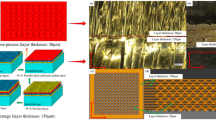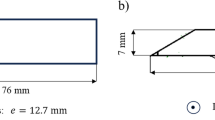Abstract
The purpose of this paper is to investigate the model of the static tool influence function (sTIF) of bonnet polishing (BP). Three kinds of sTIF are mathematically modeled, which are static tool influence function of tilted polishing (sTIFt), static tool influence function of discrete precession polishing (sTIFd), and static tool influence function of continuous precession (sTIFc), respectively. Pressure distribution in the contact area is confirmed based on finite element analysis (FEA) technology. A group of experiments to extract the polishing spots have been conducted to verify the accuracy of the sTIF model. Meanwhile, the difference between sTIFd and sTIFc is studied. It turns out that the removal depths of sTIFd and sTIFc are almost the same, and the continuous precession polishing can be replaced by discrete precession polishing to ease control in practical polishing process especially for the aspheric surfaces polishing.
Similar content being viewed by others
References
Bingham RG, Walker DD, Kim DH, Brooks D, Freeman R, Riley D (2000) Novel automated process for aspheric surfaces. Proc SPIE 4093:281–289
Walker DD, Beaucamp A, Brooks D, Doubrovski V, Cassie M, Dunn C, Freeman R, King A, Libert M, McCavana G, Morton R, Riley D, Simms J (2004) Recent development of precessions polishing for larger components and free-form surfaces. Proc SPIE 5523:445–448
Walker DD, Brooks D, King A, Freeman R, Morton R, McCavana G, Kim SW (2003) The ‘precessions’ tooling for polishing and figuring flat, spherical and aspheric surfaces. Opt Express 11(8):958–964
Walker DD, Freeman R, Morton R, McCavana G, Beaucamp A (2006) Use of the ‘precessions’ ™ process for prepolishing and correcting 2D & 21/2D form. Opt Express 14(24):11787–11795
Walker DD, Yu G, Li H, Messelink W, Evans R, Beaucamp A (2012) Edges in CNC polishing: from mirror-segments towards semiconductors, paper 1: edges on processing the global surface. Opt Express 20(18):19787–19798
Li H, Walker DD, Yu G, Sayle A, Messelink W, Evans R, Beaucamp A (2013) Edge control in CNC polishing, paper 2: simulation and validation of tool influence functions on edges. Opt Express 21(1):370–381
Jones RA (1986) Computer-controlled optical surfacing with orbital tool motion. Opt Eng 25(6):785–790
Allen LN, Romig HW (1990) Demonstration of an ion figuring process. Proc SPIE 1333:22–33
Jiao C (2008) Study on the material removal mechanisms and fundamental processes for ion beam figuring optical mirrors. Dissetation, National University of Defense Technology
Dai Y, Song C, Peng X, Shi F (2010) Calibration and prediction of removal function in magnetorheological finishing. Appl Opt 49(3):298–306
Kordonski W, Jacobs S (1996) Magnetorhelogical finishing. Int J Mod Phys B 10:2837–2848
Fähnle OW, Brug H, Frankena HJ (1998) Fluid jet polishing of optical surfaces. Appl Opt 37(28):6671–6673
Shiou FJ, Loc PH, Dang NH (2013) Surface finish of bulk metallic glass using sequential abrasive jet polishing and annealing processes. Int J Adv Manuf Technol 66(9–12):1523–1533
Tsai FC, Yan BH, Kuan CY, Hsu RT, Hung JC (2009) An investigation into superficial embedment in mirror-like machining using abrasive jet polishing. Int J Adv Manuf Technol 43(5–6):500–512
Yang L (2001) Advanced technology of optics manufacturing. Science Press, Beijing
Lin TR (2007) An analytical model of the material removal rate between elastic and elastic-plastic deformation for a polishing process. Int J Adv Manuf Technol 32(7–8):675–681
Yi HS, Yang HS, Lee YW, Kim SW (2011) Kernel TIF method for effective material removal control in rotating pitch tool-based optical figuring. Int J Adv Manuf Technol 55(1–4):75–81
Kim DW, Kim SW (2005) Static tool influence function for fabrication simulation of hexagonal mirror segments for extremely large telescope. Opt Express 13(3):910–917
Mittal R, Singh R, Joshi SS (2012) Elastohydrodynamic lubrication modeling of hydrodynamic nanopolishing process. J Manuf Sci Eng 134(4):041001–041011
Kim DW, Park WH, Kim SW, Burge JH (2009) Parametric modeling of edge effects for polishing tool influence functions. Opt Express 17(7):5656–5665
Author information
Authors and Affiliations
Corresponding author
Electronic supplementary material
Below is the link to the electronic supplementary material.
ESM 1
(DOCX 12 kb)
Rights and permissions
About this article
Cite this article
Wang, C., Wang, Z., Yang, X. et al. Modeling of the static tool influence function of bonnet polishing based on FEA. Int J Adv Manuf Technol 74, 341–349 (2014). https://doi.org/10.1007/s00170-014-6004-3
Received:
Accepted:
Published:
Issue Date:
DOI: https://doi.org/10.1007/s00170-014-6004-3




